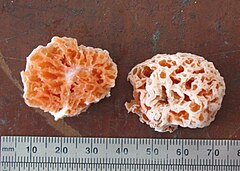Spongiforma squarepantsii
| Spongiforma squarepantsii | |
|---|---|

| |
| Two halves of the orangish sponge-like fungus, with a ruler shown at the bottom for scale. | |
| Scientific classification | |
| Domain: | Eukaryota |
| Kingdom: | Fungi |
| Division: | Basidiomycota |
| Class: | Agaricomycetes |
| Order: | Boletales |
| Family: | Boletaceae |
| Genus: | Spongiforma |
| Species: | S. squarepantsii
|
| Binomial name | |
| Spongiforma squarepantsii Desjardin, Peay & T.D.Bruns (2011)
| |

| |
| Map of Sarawak, Malaysia, location of Lambir Hills National Park | |
Spongiforma squarepantsii is a
Taxonomy and classification
History
The species was first described scientifically online in May 2011 in the journal
The genus name Spongiforma refers to the sponge-like nature of the fruit body, while the
Description
The fruit body of Spongiforma squarepantsii is bright orange coloured, roughly spherical to oval, and measures 3–5 cm (1.2–2.0 in) wide by 2–3 cm (0.8–1.2 in) tall. Although it lacks a stipe, it has a rudimentary columella—a small cord of sterile tissue that extends to the center of the fruit body. The surface of the fruit body has deep ridges and folds somewhat resembling a brain. It is sponge-like and rubbery—if water is squeezed out, it will resume its original shape. The surface has irregular, relatively large cavities (locules), lined with fertile (spore-producing) tissue. The locules are between 2 and 10 mm (0.1 and 0.4 in) in diameter. The ridges of the locules are pale orange or lighter and ciliate (having hairlike projections). Fruit bodies have a strong odour described as "vaguely fruity or strongly musty".[4] The mushroom tissue turns purple when a drop of 3% potassium hydroxide (KOH) is applied. In mass, the spores are a reddish-brown or deep mahogany colour.[4] The edibility of the fruit body is unknown.[6]

The almond-shaped
Similar species
The related species Spongiforma thailandica, newly described in 2009,[3] differs from S. squarepantsii in several ways: it has larger fruit bodies, 5–10 cm (2.0–3.9 in) wide by 4–7 cm (1.6–2.8 in) tall; its gleba is initially pale greyish-orange to brownish-grey before darkening to reddish-brown or dark brown; and it smells of coal tar. Microscopically, S. thailandica has spores with less prominent surface warts.[4]
Habitat and distribution
Spongiforma squarepantsii was found growing on the ground in Lambir Hills National Park (Sarawak State, Malaysia), northern Borneo (4°20′N 113°50′E / 4.333°N 113.833°E). This tropical rainforest receives about 3,000 millimetres (120 in) of rain yearly, with average temperatures ranging from 24 to 32 °C (75 to 90 °F).[4] The structure of the fruit body allows it to quickly revive when dry by absorbing moisture from the air.[7] The distinctive odour of the species may indicate that spore dispersal is mediated by animals.[4]
References
- . Retrieved 18 November 2021.
- PMID 19878464.
- ^ a b Desjardin DE, Binder M, Roekring S, Flegel T (2009). "Spongiforma, a new genus of gasteroid boletes from Thailand" (PDF). Fungal Diversity. 37: 1–8.
- ^ S2CID 15849227.
- ^ GrrlScientist (22 June 2011). "The new fungus from Bikini Bottom". Punctuated Equilibrium, The Guardian. Retrieved 5 October 2011.
- ^ Willingham E. (22 June 2011). "Dennis Desjardin: A fungus named after SpongeBob". Earthsky.org. Retrieved 5 October 2011.
- ^ Staff writer (22 June 2011). "SpongeBob lends name to new mushroom species". BBC. Retrieved 5 October 2011.
External links
 Media related to Spongiforma squarepantsii at Wikimedia Commons
Media related to Spongiforma squarepantsii at Wikimedia Commons

